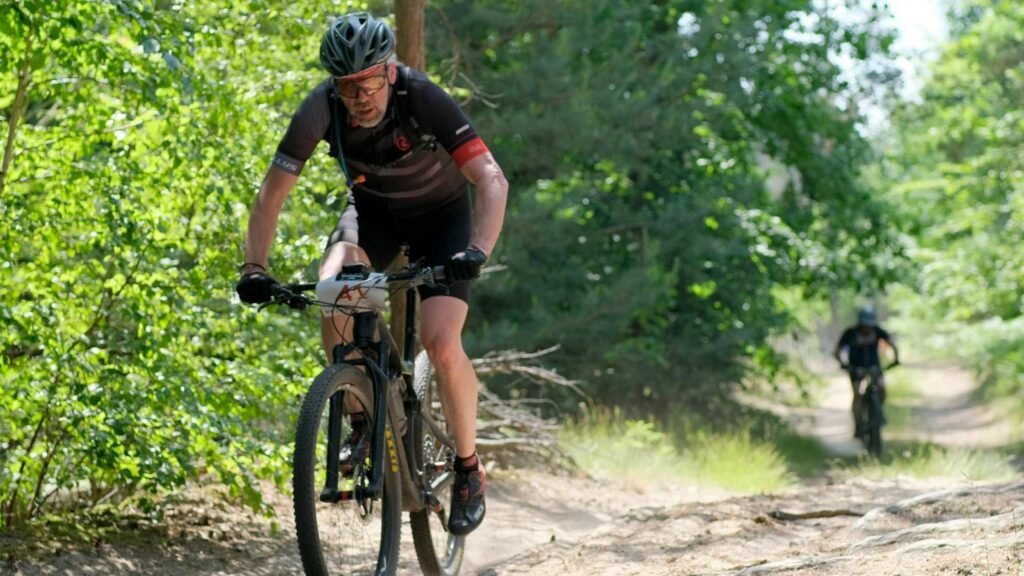When it comes to cycling endurance tips, most riders think it’s all about riding longer hours. Though it’s true, it’s not enough.
You’ll also need to train your body and mind to perform when your energy dip hits.
Let’s break it down — what really helps you build real cycling endurance that lasts, without overtraining or burning out.
1. Build a Strong Base (Start Slow, Then Grow Steady)

This is where everything begins. You can’t build endurance overnight.
You have to start with steady rides at a moderate pace, where you can still talk easily — this is your Zone 2.
It’s not about going fast; it’s about teaching your body to use fat as fuel efficiently.
If you’re starting fresh or coming back after a break, ride 3 to 4 times a week for around 45–60 minutes each.
Then slowly increase your weekly mileage by about 10% every week. Don’t rush that part.
Pro Tip: Many new riders jump to intensity too soon and hit fatigue early. The real improvement in endurance happens when you stay disciplined in low-intensity rides for weeks before pushing harder.
You can also read: What Happens If You Bike Every Day for 30 Minutes — it’s the base principle that works for both road and mountain biking.
2. Mix in Long Rides (But Ride Smart)

Once your base feels stable, introduce one long ride every week.
This ride should push your endurance limits slightly — not destroy you.
If you’re riding on the road, plan for 2 to 3 hours at a steady pace.
For mountain biking, go by terrain effort, not time.
A 90-minute technical trail can drain you more than a 3-hour road spin.
So I recommend it! Pace yourself early. Don’t chase speed; chase longevity.
Your goal should be to keep your energy consistent from start to finish.
You can also try alternating between flat routes and hilly terrain — that change keeps both your legs and lungs guessing.
It will improve aerobic strength naturally.
Remember: Endurance builds when you stress the system just enough — not when you finish every ride completely wrecked.
3. Focus on Nutrition & Fueling During Rides

You can’t out-train poor fueling.
To ride long, you need to eat and drink right — both before and during the ride.
Before your long ride, have a meal rich in complex carbs and a little protein (like oatmeal, banana, or peanut butter toast).
During the ride, start fueling early — every 30–45 minutes, take in 30–60 grams of carbs. That could be gels, fruits, or energy bars.
Hydration tip: Sip every 10–15 minutes, not when you’re already thirsty. Add electrolytes on hot days — they make a huge difference in endurance.
You will feel this especially on mountain climbs or windy road sections.
When you fuel right, your energy stays even, and your muscle fatigue kicks in much later.
If you haven’t yet, check 9 Effective Ways to Build Stamina for Longer Mountain Bike Rides — I explained more there about nutrition timing and stamina-building rides.
4. Interval Training (But Only After Your Base)
Once your base is strong, add interval training once or twice a week.
It’s like giving your endurance a turbo boost.
For road cycling, go for tempo intervals — ride 10–15 minutes at a comfortably hard pace, rest for 5, repeat 3–4 times.
For mountain biking, do short hill repeats — climb a tough hill for 2–3 minutes, recover on the way down, repeat.
These sessions train your heart and lungs to recover faster, meaning you can go longer with less fatigue.
Don’t overdo HIIT-style rides if your main goal is endurance. Keep most rides easy, and let 1–2 per week challenge your limits.
5. Strength Training — The Overlooked Secret

Cyclists often skip strength work, but if you want real endurance, your core and legs need stability and power.
You don’t need heavy gym sessions. Just 2 days a week of functional moves like:
- Squats
- Lunges
- Planks
- Deadlifts (light to moderate)
- Glute bridges
Even 15–20 minutes after your ride helps a lot.
Stronger muscles mean more efficiency per pedal stroke, which saves energy on longer rides.
If you’re over 35 or starting later in life, this becomes even more important.
You can read: Starting Mountain Bike at 40 – 10 Tips to Follow. It’s packed with strength advice that fits perfectly for endurance riders, too.
6. Master Recovery & Sleep (You Don’t Grow While Riding)

Endurance isn’t built while you’re riding — it’s built while you recover.
That’s when your body repairs and adapts.
Take at least one full rest day per week.
If you’re training hard, maybe even two. Don’t be afraid of rest — it’s part of the training.
Also, never skip a Good Sleep. 7–8 hours is non-negotiable.
Poor sleep = slower recovery + less performance the next day.
You’ll notice that when you respect rest, your rides get smoother, your mood stays better, and even your climbs feel easier.
7. Train Your Mind for Endurance
Most riders hit a wall not because their body gives up — but because the mind does.
The longer you ride, the more your thoughts start convincing you to quit.
Train your brain just like your legs. Practice mental endurance:
- Break long rides into segments. Focus on reaching the next hill, next corner, or next rest stop.
- Use positive talk — literally tell yourself, “just 10 more minutes.”
- Ride solo sometimes. It builds resilience and self-reliance.
Remember, endurance isn’t only a physical skill.
The best endurance riders have strong patience — and that grows only with experience.
8. Ride Variety — Don’t Stick to One Terrain

If you always ride on smooth roads, your endurance will struggle on trails.
If you only ride off-road, your steady stamina might lag behind.
Mix both. Alternate between mountain trails and road sessions.
The balance helps your muscles adapt differently and makes you an all-around stronger cyclist.
This cross-training effect also prevents burnout — both physically and mentally.
And yeah, switching terrains keeps things fun. You won’t get bored repeating the same loop.
9. Focus on Cadence & Efficiency
Endurance isn’t just enough to increase heart rate or distance. It’s also how efficiently you ride.
When you ride with a smoother cadence, you’ll better sustain your energy.
So, aim for 85–95 RPM on flat terrain.
Don’t mash gears at slow cadence — that drains your legs faster.
Instead, spin lightly and let your cardiovascular system do more of the work.
If you use clipless pedals, they can help with smooth power delivery, but if you prefer flats, that’s fine too — both have their strengths. You can read more here: Clipless vs Flat Pedals – Which One Should You Really Choose.
Small tweak: Keep your upper body relaxed, shoulders loose, and eyes scanning ahead. Efficiency starts with posture, not just pedaling.
10. Plan Recovery Weeks
After every 3 to 4 weeks of consistent training, plan one recovery week.
It doesn’t mean you stop riding — just reduce volume by about 40–50% and drop intensity.
This allows your body to absorb all the training you’ve done so far.
If you skip recovery weeks, fatigue builds up silently, and your progress plateaus.
So don’t worry if you feel lazy during that week — it’s where real adaptation happens.
11. Keep Tracking & Adjusting
Keep a simple log — how long you rode, how you felt, what terrain you covered.
You don’t need fancy gadgets; even notes on your phone are fine.
Patterns will show up: which foods worked, which rides drained you more, and what cadence felt smoothest.
Use that info to tweak your training.
This is how you actually improve cycling endurance — not by blindly copying someone else’s plan, but by learning your own body’s rhythm.
12. Ride with Purpose, Not Just Routine
You can’t build endurance only by miles but by intent.
Every ride should have a reason — even an easy spin.
- Some days, it’s about recovering.
- Other days, pushing your long-ride limits.
- Sometimes, just improving pedal technique.
When you ride with a goal each time, you will progress faster — and the improvement will feel more satisfying.
If you’re new or starting later in life, you’ll enjoy this read too: What Is the Best Age to Start Mountain Biking.
It’ll motivate you to believe age is never a barrier to endurance.
13. Learn to Listen to Your Body
This might sound simple, but it’s one of the hardest things to do.
Your body constantly tells you how it feels — tired, fresh, sore, or strong — but we often ignore it, trying to “stick to the plan.”
Real endurance athletes know when to push and when to pause.
If your legs feel heavy two days in a row, cut the ride shorter.
If you wake up feeling strong, stretch your limit that day.
Endurance grows only when your body is ready to adapt.
Forcing progress never works long-term.
14. Stay Consistent (That’s Where the Magic Happens)
At the end of the day, consistency beats intensity.
You don’t need epic rides every week — you just need to keep showing up.
Even if you ride short, steady sessions 4–5 times a week, you’ll see more improvement than doing one “monster” ride occasionally.
Keep riding, keep learning your limits, and watch your cycling endurance skyrocket over time.
Conclusion
Cycling endurance isn’t something that just happens — you earn it. One ride at a time.
Some days, you’ll feel like your legs just don’t have it. Some days you’ll surprise yourself, going way longer than expected.
But that’s how it builds — quietly.
So be consistent, even when you don’t feel like it.
And soon, you will start feeling that rhythm — your breathing syncing with the road, the climb not scaring you anymore, etc.
Doesn’t matter if it’s mountain or road, it’s just you, the bike, and how far you can go.
So yeah, keep riding. Keep learning your body. Don’t chase someone else’s pace — build your own.
FAQs – Cycling Endurance Tips
Here are some important questions and answers.
How long does it really take to build good cycling endurance?
It depends on where you’re starting from, but usually, around 7 to 8 weeks of steady, smart riding, you’ll start feeling the change.
Longer rides won’t feel like punishment anymore.
Give it 3 months of consistent training, and your stamina, speed, and recovery will all be at a new level.
Should I bike every single day to improve endurance?
No. That’s actually one of the biggest mistakes most riders make.
You can ride often, but your body needs to recover, too. 4 to 5 days a week is perfect for most.
One long ride, one interval session, rest in between. If you overtrain, your endurance drops, not increases.
You can check this article — What Happens If You Bike Every Day for 30 Minutes — it explains how daily riding really affects your body.
Which one builds more endurance — mountain biking or road cycling?
Both do, just in different ways. Road cycling gives you that long, steady stamina — your heart and lungs get strong.
Mountain biking builds the muscular side — all those climbs, descents, and gear shifts toughen you up.
Honestly, mix both. That’s what keeps you balanced and ready for any ride.
What’s the most important tip for building cycling endurance?
Consistency. 100%. You can have the best bike, the best plan, but if you’re not consistent, nothing sticks.
And recovery — don’t forget that.
Endurance builds when your muscles repair and adapt. You can push hard, sure, but you’ve got to rest smart, too.
How will I know if my endurance is improving?
Simple. When those same climbs don’t burn your legs as much, or when you can ride 10 to 20 km more without feeling drained — that’s your progress showing.
Also, your recovery gets faster. You’ll notice you’re less tired the next day, even after a tough ride.

Ali is the founder of Mountain Bike Insider and an passionate rider with years of hands-on experience in mountain biking. From testing gear to exploring trails, Ali writes based on real riding knowledge to help others make smart, safe, and enjoyable biking choices. Every guide is built on research, personal use, and a passion for the sport.







